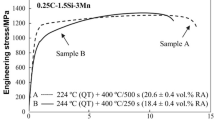Abstract
The hot deformation behavior of 18CrNiMo7-6 steel at temperatures of 900 ~ 1150 °C and strain rate of 0.01 ~ 5 s−1 was studied by isothermal single-pass compression experiment. The critical recrystallization model was used to determine the relationship between the critical stress and the peak stress as \(\sigma_{{\text{c}}} /\sigma_{{\text{p}}} = 0.89\). Meanwhile, the dynamic recrystallization mechanism of the samples at different deformation stages was analyzed by electron backscatter diffraction (EBSD) and metallographic microscope. The microstructure evolution shows the following: when the strain is 0.05, the work hardening is the main mechanism, and the lattice distortion near the grain boundary leads to the accumulation of dislocations, which provides the impetus for the recrystallization nucleation at the grain boundary; when the strain is 0.2, the dynamic recrystallization mechanism crystal has just started, and the small-sized recrystallized grains are formed at the grain boundary; in the meantime, dislocation rearrangement occurs in the coarse grain. When the strain is 0.5, the dynamic recrystallization consumes a large number of low-angle grain boundaries into high-angle grain boundaries by means of subgrain rotation and finally forms fine recrystallized grains in the coarse grains. This process will continue until the end of recrystallization, and the dislocations in the material matrix will tend to homogenize.













Similar content being viewed by others
References
Mandal P, Olasolo M, Da Silva L, and Lalvani H, Metallur Mater Transactions (2020). https://doi.org/10.1007/s11661-020-05728-x
An X, Tian Y, Wang B, Jia T, Wang H, and Wang Z, Surf Coat Technol (2021). https://doi.org/10.1016/J.SURFCOAT.2021.127348
Yamamoto Y, Muralidharan G, and Brady M P, Scripta Materialia 69 (2013) 816. https://doi.org/10.1016/j.scriptamat.2013.09.005
Chen L L, Luo R, Yang Y T, Peng C T, Gui X, Zhang J, Song K Y, Gao P, and Cheng X N, Trans Indian Inst Met (2019). https://doi.org/10.1007/s12666-019-01674-4
Mandal S, Bhaduri A K, and Subramanya Sarma V, Metallur Mater Transactions 43 (2012) 2056. https://doi.org/10.1007/s11661-011-1012-5
Xie Y, Wang Q, Chen Z, Wu X, Liu H, and Wang Z, Metals (2022). https://doi.org/10.3390/MET12050838
Fang B, Ji Z, Liu M, Tian G, Jia C, Zeng T, Hu B, and Chang Y, Mater. Sci. Eng. A. (2014). https://doi.org/10.1016/j.msea.2013.11.016
Wei Z, Peng G, Qian L, Shewei X, and Jun C, Rare Metal Mater Eng 45 (2016) 1732.
Wang X, Chandrashekhara K, Lekakh S N, Van Aken D C, and O’Malley R J, Steel Res Int (2019). https://doi.org/10.1002/srin.201700565
Duan C, Zhang F, Qin S, Sun W, and Wang M, J Mech Sci Technol (2018). https://doi.org/10.1007/s12206-018-0828-y
Gaofei L, Changqing L, and Yuan F, Steel Res Int (2012). https://doi.org/10.1002/srin.201100319
Huang C Q, Deng J, Wang S X, and Liu L L, Mater Sci Eng A (2017). https://doi.org/10.1016/j.msea.2017.04.086
Dai Q, Deng Y, Wang Y, Huang W, Materials (Basel, Switzerland) (2020) https://doi.org/10.3390/ma13214982
Lin Y C, Chen X M, Wen D X, and Chen M S, Comput Mater Sci (2014). https://doi.org/10.1016/j.commatsci.2013.11.003
Poliak E I, and Jonas J J, ISIJ Int. (2003). https://doi.org/10.2355/isijinternational.43.684
Mirzadeh H, Cabrera J M, and Najafizadeh A, Acta Materialia. (2011). https://doi.org/10.1016/j.actamat.2011.07.008
Lin Y C, Liang Y J, Chen M S, and Chen X M, Appl Phys A (2017). https://doi.org/10.1007/s00339-016-0683-6
Luo R, Zheng Q, Zhu J J, Guo S, Li D S, Xu G F, and Cheng X N, Rare Metals (2019). https://doi.org/10.1007/s12598-016-0871-8
Geng P, Qin G, Zhou J, and Zou Z, J Manuf Process (2018). https://doi.org/10.1016/j.jmapro.2018.03.017
Ryan N D and McQueen HJ, J. Mater Process Technol (1990) https://doi.org/10.1016/0924-0136(90)90005-F
Zheng Q, Chen L, Luo R, Qiu Y, Peng C T, Liu T, Cui S, Cao Y, Gao P, Cheng X, Transactions Indian Inst. Metals(prepublish) (2020) https://doi.org/10.1007/s12666-020-02096-3.
Najafizadeh A, and Jonas J J, ISIJ Int (2006). https://doi.org/10.2355/isijinternational.46.1679
Zhu H, and Ou H, Mater Sci Eng A (2022). https://doi.org/10.1016/J.MSEA.2021.142473
An J, Zhou M, Tian B, Geng Y, Ban Y, and Liang S, Sci Eng Comp Mater (2021). https://doi.org/10.1515/SECM-2021-0044
Medina S F, and Hernandez C A, Acta Materialia (1996). https://doi.org/10.1016/1359-6454(95)00151-0
Chen W, Zheng C, and Dianzhong L, J Phys Conf Ser (2019). https://doi.org/10.1088/1742-6596/1270/1/012047
Sun Y, Zhang C, Feng H, Zhang S, Han J, Zhang W, Zhao E, Wang H, Mater Charact (prepublish) (2020) https://doi.org/10.1016/j.matchar.2020.110281
Belyakov A, Miura H, and Sakai T, Mater Sci Eng A (1998). https://doi.org/10.1016/S0921-5093(98)00784-9
Li X, Zhao J, Dong L, Misra R D, W X, Wang X and Shang C, Materials (Basel, Switzerland) (2020) https://doi.org/10.3390/ma13225095
Zhang Q, Li Q, Chen X, Bao J, and Chen Z, Mater Sci Eng A (2021). https://doi.org/10.1016/J.MSEA.2021.142026
Kumar N V R, Blandin J J, Desrayaud C, Montheillet F, and Suéry M, Mater Sci Eng (2003). https://doi.org/10.1016/S0921-5093(03)00334-4
Acknowledgements
This project is sponsored by National Key R&D Program of China ((Nos. 2020YFB2008100)
Author information
Authors and Affiliations
Corresponding author
Additional information
Publisher's Note
Springer Nature remains neutral with regard to jurisdictional claims in published maps and institutional affiliations.
Rights and permissions
Springer Nature or its licensor (e.g. a society or other partner) holds exclusive rights to this article under a publishing agreement with the author(s) or other rightsholder(s); author self-archiving of the accepted manuscript version of this article is solely governed by the terms of such publishing agreement and applicable law.
About this article
Cite this article
Xie, Y., Chen, Z., Zhu, Q. et al. Study on Recrystallization Initiation Model and Microstructure Evolution Mechanism of 18CrNimo7-6 Steel During Hot Deformation. Trans Indian Inst Met 76, 1841–1851 (2023). https://doi.org/10.1007/s12666-022-02862-5
Received:
Accepted:
Published:
Issue Date:
DOI: https://doi.org/10.1007/s12666-022-02862-5




